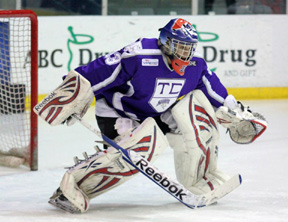Penalties
There
have been penalties in hockey since the first time the rules were written
down in 1877. No player could trip, kick or charge an opposing player.
However, there were no penalties.
Nine years later when new rules were written, that list was extended to add
collaring, shoving, and raising the stick above shoulder height. An offender
would be warned by the referee twice and if he did it again he was out for
the rest of the game.
The
first time penalty times were charged was in 1904. Ten years later a money
fine could be charged as well as the penalty of 5 minutes. We are talking
pro teams here obviously. The practice of fines apparently did not last
long. Penalty minutes were reduced to 3 but were not very effective since a
substitute could be sent in. It wasn’t until the 1917-18 season that teams
skated shorthanded when a penalty was called. There was a penalty for
“loafing offside” that year.
In the 1918-19 hockey season the penalty rules were changed to set three
minutes for a minor foul and five minutes for a major one. No substitutions
were allowed during either of those periods of time. There was a penalty for
“loafing offside” that year. If there was a “match foul,” that is, if a
player was suspended for the rest of the game, no substitute could be sent
in.
Two seasons later the
3-minute minor foul was changed to two minutes.
In the 1923-24 season match fouls were defined as actions deliberately
injuring or disabling an opponent. For such actions, a player was fined not
less than $50 and ruled off the ice for the balance of the game. A player
assessed a match penalty could be replaced by a substitute at the end of 20
minutes. Match penalty recipients had to meet with the League president who
could assess additional punishment.
During the 1920’s and early 30’s several minor penalty rules were
introduced. The delayed penalty concept was established. Minor penalties
could be dished out for deliberately picking up the puck while it was in
play (except for the goalie), for delaying the game by passing the puck back
into the player’s defensive zone, and for deliberately shooting the puck out
of play. In 1970 that last penalty description was expanded to include
deliberately shooting the puck out of the playing area.
We have all heard the stories about fans being injured by pucks flying into
the stands so we know a puck flies hard and fast. But have you ever thought
about how far a puck can fly? Once at s Storm home game a practice puck hit by a
visiting player flew over the stands, up and over the suites and landed on
the concourse near the wall back by the Storm Store.
Once the puck was passed up ice, no more than two players besides the goalie
could stay back in the defensive zone. If this happened more than two times
in the game the team would be given a major penalty instead of a minor one.
The penalty for high sticking was introduced and no player except the goalie
was allowed to fall on the puck if it was within 10 feet of the goal.
In the 1950’s the rule was
established that when a power play goal was made, the player in the penalty
box could return to the ice. Up until then even if a goal was scored, the
team continued to play shorthanded through the entire penalty time. A short
time later the issue of penalty shots was addressed. The shot was to be
taken by the player against whom the foul was committed. If the foul was not
against a specific player, any of the players on the ice could take the
shot.
Twenty years later
a team could receive a bench minor if a player who had received a penalty
did not go directly to the penalty box.
Fighting penalties in the 1970’s included a game misconduct for a third
player entering an altercation and establishing a major penalty plus game
misconduct for a player who was clearly the instigator. Also at that time
the rule was established that if a team questioned the legality of a stick
and asked that it be measured, and if the stick was legal they would be
given a minor penalty.
In
the 1990’s checking from behind into the boards or into the goal frame would
earn a player a major penalty and game misconduct. Goalie interference or
infringing on the goal crease resulted in minor penalties. “Diving” resulted
in a minor penalty also.
We know that no team can have fewer than three players (plus the goalie) on
the ice. During regulation play if a team is two players down and draws a
third penalty, the third penalty time does not start until the first penalty
ends. But what happens in overtime? Now there are only four players on each
side. What if a team draws two penalties? That would mean they would have
only two players on the ice verses the four on the power play team. In the
1999-00 season a rule was adopted to deal with this situation. The penalized
team would still have three players on the ice. But so that their opponents
would have the 2-player advantage, they could put a fifth player on the ice.
http://www.njyhl.org/pages/hockey101/101_penalties.html
http://www.tmlfever.com/thegame.html
|
|

